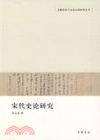
Sun Liyao 孫立堯
Beijing: Zhonghua Shuju Press, 2009
Reviewed by Li Yueyan (Ph.D. Candidate, Literature, Nanjing University; Harvard-Yenching Institute visiting fellow)
The Study of Historical Commentaries in the Song Dynasty is based on Sun Liyao’s Ph.D. dissertation and is part of a series on “the study of classics’ heritage and cultural identity.” Sun is currently an associate professor in the Department of Chinese Literature at Nanjing University.
Sun’s book defines Shilun (史論) as a commentary on historical process, events, and figures. Historical commentaries were an important phenomenon throughout the entirety of Chinese history. Moreover, the Song Dynasty was considered as one of the key periods in which historiography and historical commentaries greatly developed. Shilun in the Song Dynasty is a style that combines historiography, Confucianism, literature, and politics. Nevertheless, this is the first book that provides a systemic study on Shilun’s origin and development before the Yuan Dynasty.
Sun is quite cautious. He does not expand the scope of historical commentaries to poetry, odes, epigraphs, etc., because in his opinion they are only literary texts and not a part of historiography. In defining Shilun, the author analyzes briefly the different styles of historical commentaries and the history of Shilun in the pre-Song time. He then focuses on the prose of historical events and figures.
Sun’s ideas and interpretations are inspiring. At the beginning of the book, he points out that Shilun was just a part of historical texts before the Song Dynasty but it became a more independent form of historical text after the Song Dynasty. The author also notes the relation between the political narrative and historical commentaries. The obvious examples are Li Gang’s and Li Tao’s historical commentaries. What is more, according to Sun, Shilun in the post-Song era were quite different from those in pre-Song times. Two changes in Shilun were influenced by two trends during Song Dynasty: the literary trend in the Northern Song Dynasty and the Neo-Confucian trend in the Southern Song Dynasty. The advantage of the Neo-Confucian trend is that the scholars in the Southern Song Dynasty tried to research the inner world of the historical figures in order to reach self-cultivation. This is also the aim of modern historiography. However, the negative influence of the Neo-Confucian trend was empty talk, while the worst effect of this literary trend was embellishing the actual history to raise new points or write a more attractive piece. In this process, the historical spirit of Shilun was distorted.
Even though Sun differentiates the two changes according to period, he does not ignore the complicated situation in individual prose. For example, he identifies the relationship between historical commentary and Confucianism in Sima Guang and Fan Zuyu’s Shilun in the Northern Song Dynasty. The author also includes a chapter on the influence of the literary trend in the early Southern Song Dynasty. Based on those specific analyses, the reader can understand the academic origin and development, e.g. the progress of utilitarianism from Ouyang Xiu, Li Gou, and Wang Anshi to Lv Zuqian, Cheng Liang, Ye Shi, Gu Yanwu, and Yan Yuan.
Nevertheless, Sun uses the phrase “historical theory” rather than “historical commentary” in his thesis “One Explanation for ‘History, Part of Confucianism’: Also on the Historical Theories of Si-ma Guang and Fan Zuyu” (《“史者儒之一端”試解——兼論司馬光、范祖禹的史論》). He defines Shilun as a theory. It depends on many reasons, and one of them might be that in Sun’s opinion traditional Chinese historiography is very different from Western historiography. He claims the counterpart in traditional Chinese historiography to Western historiography is Shilun, which is an analysis of history. Another reason for using “historical theory” might be that history and Confucianism are intertwined in Sima Guang and Fan Zuyu’s Shilun, since they were both historians and Confucians.
If Sima Guang and Fan Zuyu are excluded from the group of Neo-Confucians, the concept of “the Neo-Confucian trend in the Southern Song Dynasty” may make sense. However, if Neo-Confucianism in the Song Dynasty is not confined to the academic school of the Cheng brothers and Zhu Xi, it might be inappropriate to limit the Neo-Confucian trend to the Southern Song Dynasty. Moreover, as Sun’s analysis shows, the literary trend also existed in the Southern Song Dynasty. The literary trend was more pronounced in Northern Song Dynasty, while the Neo-Confucian trend was strong in the Southern Song Dynasty, but it might be preferable to analyze each trend separately rather than to divide the two trends by the two dynasties.
The development of Shilun in the Song Dynasty was varied, and The Study of Historical Comments in the Song Dynasty clearly shows its complexity. Sun thinks that Chen Yinque’s statement “each historical commentary is political narrative” may belittle the value of Shilun. Actually, it depends on how one defines higher value. Nevertheless, the cultural history perspective of Sun’s analysis helps readers better understand main trends in traditional Chinese culture.
